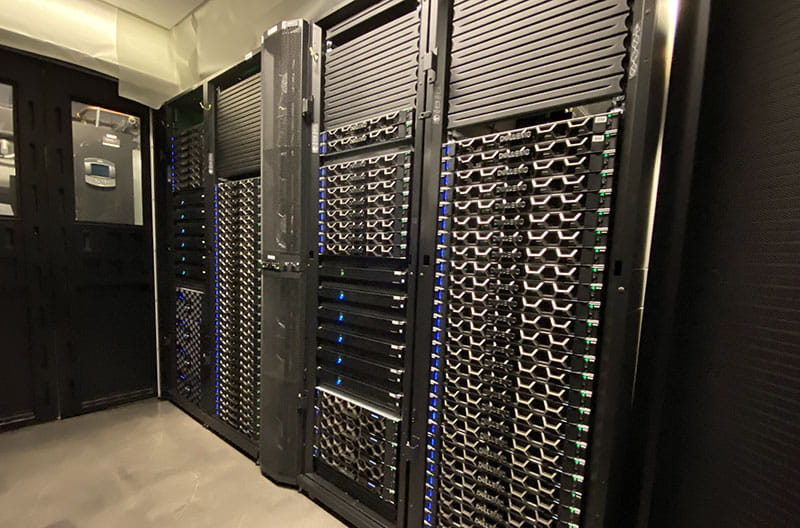Drexel Names New Computing Cluster After Historic Alumna

Back in 2014, when researchers affiliated with Drexel University’s University Research Computing Facility (URCF) were deciding the name of its first high-performance computer cluster, they went with an ancient, mythological choice: Proteus, the shape-changing sea god from Greek mythology.
When naming its replacement computer cluster, the URCF went with something a little closer to home.
Picotte, which opened in February, is named in honor of Susan La Flesche Picotte (1865-1915), MD, who, according to current research, was the first Native American to become a physician in the U.S. Picotte graduated in 1889 from one of the Drexel University College of Medicine’s predecessor schools, Woman’s Medical College of Pennsylvania (WMCP), one of the world’s first medical schools for women and one that graduated many trailblazing doctors.
The daughter of Pierre La Flesche, or Iron Eye, a leader of the Omaha tribe, Picotte grew up on the Omaha Reservation in Nebraska during a period in which the U.S. government was forcing tribes to move onto reservations and assimilate into white society. She was inspired to become a doctor after watching a sick Native American woman die after a white doctor refused to treat her. After graduating a year early and at the top of her class from WMCP, she returned back west to Nebraska, first working as the only physician for the Omaha and nearby Winnebago tribes while working for the Office of Indian Affairs, and later treating patients on and off the reservation when she went into private practice. In 1913, she founded a hospital on the reservation — the first privately funded hospital on a Native American reservation — that is now a national historic landmark named in her honor.
In addition to her work and status as a medical professional, Picotte was a public health advocate, community leader and social reformer who fought to expand the rights and opportunities for the Omaha people. Her trailblazing achievements have been recognized in the medical and Native American communities, most recently in a 2020 PBS documentary, a 2016 biography and a 2017 Google Doodle.
“When we were trying to figure out a name for the new research computing core facility, we wanted to highlight a notable figure in Drexel's history, and history more widely,” said Geoffrey Mainland, PhD, an associate professor of computer science in the College of Computing & Informatics and chair of the URCF’s Board of Governance. “As well as being substantially faster than its predecessor, the Picotte cluster adds support for researchers working with protected health information (PHI), which will enable a whole new class of computational healthcare-related research at Drexel.”
Picotte, and the URCF in general, is an important resource for the faculty, professional staff and students doing computational work at Drexel across many different domains and fields. It offers centralized costs, support and resources all in one place specifically outfitted to support that kind of computing facility — with Senior Systems Administrator David Chin, PhD, on hand to manage and run it. Faculty can invest their faculty startup funding in the URCF’s existing facility, and their grants or departments can help expand it by buying additional compute nodes, rather than buying and operating their own.

Created in 2013, the URCF supports a community of people from across the University with wildly varying fields who all leverage this computational tool in their own areas. For just a few examples, there’s finite element analysis from materials engineering researchers from the College of Engineering; gene sequencing computation and computational chemistry from College of Arts and Sciences researchers; machine learning from researchers from the College of Computing & Informatics; and statistical computing from researchers from the LeBow College of Business.
Picotte features new equipment (Associate Vice President for Core Technology Infrastructure Ken Blackney negotiated the purchase from Dell), a new storage system and new infrastructure for members of the University’s computational research facility, which is part of the Office of Research & Innovation. A large part of the upgrade includes Graphical Processing Unit (GPU) nodes and large-memory machines that can process lots of data quickly, which is a major upgrade from the offerings from Proteus.
During its first five years, the facility and Proteus supported the research of over 100 active users and 70 PIs, and their teams; generated research for hundreds of papers; created new courses, supported over a dozen undergraduate and graduate classes in training students using state-of-the-art computing; and generated $53.9 million in research expenditures and 9% of the total research expenditures.
It’s a continuation of an investment the University made in high-performance computing eight years ago to create URCF and outfit it with Proteus. This marked the first time in which the University had a centralized place to house computer infrastructure, which came after a $2 million renovation of the former rifle range between the third and fourth floors in Main Building (which used to house the University’s rifle programs, including its nationally recognized women’s team, and University-wide turkey shoot competitions during the 20th century; the range was later closed when the rifle program ended in the beginning of the 21st century). Before, researchers spent their own time and money buying and maintaining their own computing technology, which were often housed in spaces without adequate cooling and noise-blocking measures (when there was even space to be found).

The equipment for Picotte was purchased using funds from an NSF Major Research Instrumentation grant to expand Proteus for data-intensive computing, which was awarded to Gail Rosen, PhD, professor of electrical and computer engineering in the College of Engineering, and three co-PIs (Brigita Urbanc, PhD, associate department head for graduate studies and professor in the Department of Physics in the College of Arts and Sciences; Antonios Kontsos, PhD, associate professor of mechanical engineering and mechanics in the College of Engineering; and Hasan Ayaz, PhD, associate professor in the School of Biomedical Engineering, Science and Health Systems). The grant was for $540,000, and Joshua Lequieu, PhD, an assistant professor of chemical and biological engineering in the College of Engineering, contributed about $150,000 of his startup funds. Drexel matched the funding, for a total purchase order of close to $1.3 million.
Rosen, who has served as a member of the URCF board since 2013 and chair from 2017 to 2019, needed faster architectures with more memory for her data intensive work in computation biology. “DNA files sampled from microbial communities around the planet take up terabytes per study,” Rosen explained, and said computation can run “in a fraction of the time on multicore GPUs,” like those now in Picotte.
The motivation to purchase the hardware for Picotte was to keep up with data-intensive applications, Rosen said, and share the infrastructure (and its consuming upkeep) with the URCF community.
“While I run a lot of computation, it can run quickly in parallel, and we need bursts of time when writing papers,” she said. “Hardware depreciates quickly — so it is more efficient use of funds if other researchers can use the equipment when we are not.”
The purchasing and implementation of Picotte is just a continuation of Rosen’s work to benefit the University’s computational research facility and community. It’s also a continuation of how her own research, and that of her group, has benefited from that work.

“Proteus has enabled my group to examine issues caused by the ‘data deluge,’ such as growing databases and experimental data, in biology,” said Rosen. “A great example is we were able to run an algorithm that classifies what organisms are in a microbiome from their DNA, using time snapshots of an exponentially growing database of genomes. We made our algorithm more efficient and showed that researchers could get better results quicker than the traditional computationally inefficient method. These simulation experiments used a lot of computation, and Proteus enabled this. Now, we just got an NSF grant to develop more efficient algorithms for identifying organisms and genes from microbiomes. We wouldn’t have been able to show the efficacy of our method if we didn’t have all the computation that Proteus provided.”
Now that Picotte is up and running — there was a delay, and many complications, due to the COVID-19 pandemic — Mainland hopes that the implementation of Picotte creates more opportunities for students and faculty in the GPU computation field, and Drexel’s diverse computational research community in general.
“This shows a real commitment and investment on the University’s part to computational science, and that’s something that’s occurring here across many disciplines,” said Mainland. “I think it speaks very well of the University that we were able to get this NSF grant, which shows that the funding agency also values the research being done at Drexel and sees promise in the work we’re doing here.”
For more information about the University Research Computing Facility, contact URCF Support. For more information on the URCF Board of Governance, contact the chair.
Drexel News is produced by
University Marketing and Communications.

